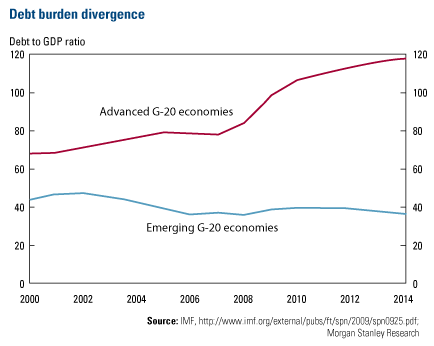It’s not a good time to be a developed economy.
Sovereign debt is at or near the crisis point in Greece, Spain, Ireland and Portugal. It’s also a big issue and getting bigger in the United States, Britain, Japan and a number of other countries.
Mohamed El-Erian, CEO at bond giant Pimco, was right when he wrote in Thursday’s Financial Times that sovereign debt represents “a significant regime shift in advanced economies with consequential and long-lasting effects.”
Debt conditions are much better in the major emerging markets, as you can see in the chart below. In the G-20 largest developed economies, sovereign debt burdens are now at about 100 percent of GDP, while in the 20 most important emerging markets, debt represents only about 40 percent of GDP.

In the next few years, the forecast sees the G-20 ratio rising another 20 percent. In the U.S., the ratio is already at its highest level since World War II, and another $10 trillion (70 percent of current GDP) will be added over the next decade. Meanwhile, the emerging 20’s sovereign debt-to-GDP actually goes down as a result of smaller budget deficits.
The lighter debt load benefits emerging markets in a number of ways, particularly in how risks are measured and perceived.
Sovereign credit ratings for emerging markets are improving, while the credit ratings of developed markets are dropping off significantly. This can be seen in the chart below—of course, developed markets still have higher ratings (left axis versus right axis) but the trend is for the key emerging markets is notably upward.

Higher credit ratings mean lower costs of capital for these countries, which is a positive for economic growth in countries that are already growing faster than the developed markets.
Now what about equity prices? Historically, there has been a negative correlation between bond prices and equity prices in developed markets, in what can be viewed as a safety trade. In emerging markets, however, we see a positive correlation between bond prices and equity prices in recent years. This makes sense to us, because both of these asset classes are driven by money flows from investors attracted by improving economic prospects in emerging countries.
Emerging markets have had appeal for risk-tolerant investors because these economies are growing faster and their companies have generated higher returns. The sovereign debt issue is reducing the relative risk of investing in both bonds and equities in these dynamic markets—in this scenario, investors should consider the equities to capture the higher return.